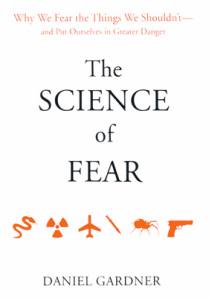Authors, activists, consultants, and futurologists are constantly warning us about threats so spectacular and exotic they make scenarios of nuclear Armageddon look quaint. - Daniel Gardner
 It is a tired book review cliché to declare a book “important”, but I’m going to do it anyway: The Science of Fear is an important book. Its author is a journalist (with a law degree) rather than a scientist, but the book is extensively researched and exhaustively footnoted, and has been praised by many psychologists and other scientists. In twelve clear and readable chapters over about 300 pages, Gardner does what so many skeptic writers fail to do in book after book: he explains not just how people immerse themselves in fearful folly, but explains why we do so. In other words, he doesn’t merely debunk hysteria by throwing statistics at it; instead, he looks at how the instincts which served us well on the African savannah betray us in the modern world.
It is a tired book review cliché to declare a book “important”, but I’m going to do it anyway: The Science of Fear is an important book. Its author is a journalist (with a law degree) rather than a scientist, but the book is extensively researched and exhaustively footnoted, and has been praised by many psychologists and other scientists. In twelve clear and readable chapters over about 300 pages, Gardner does what so many skeptic writers fail to do in book after book: he explains not just how people immerse themselves in fearful folly, but explains why we do so. In other words, he doesn’t merely debunk hysteria by throwing statistics at it; instead, he looks at how the instincts which served us well on the African savannah betray us in the modern world.
As Gardner explains, humans actually have two different kinds of thinking going on simultaneously and more or less independently of each other. “System One is the more ancient. It is intuitive, quick and emotional. System Two is calculating, slow and rational.” He refers to the two systems as “gut” and “head”, and convincingly demonstrates how gut – which worked beautifully for keeping pre-verbal humans out of trouble in a natural environment – leads to lots of serious problems in the complex, artificial world we’ve built. In early chapters he explains the various “rules” hard-wired into our brains which are the source of the problem:
The Law of Similarity tells our brains that things are what they look like. In nature, a new creature which looks like a lion is probably best avoided, while one that looks like an antelope is probably edible. But this principle is also the basis for sympathetic magic (the idea that harming the image of a thing also hurts the original), which in the modern age has given us censorship, draconian “child porn” laws, and neofeminists’ belief that what other women do in private magically affects them.
The Anchoring Rule means that when humans are exposed to a number, any numerical estimates which closely follow exposure are adjusted from the first number rather than calculated independently, even if the numbers have nothing to do with one another. In other words, if I took a group of people and asked them for an estimate of the number of “child sex slaves” in the US, but told them that the oft-repeated claim of 300,000 is wildly incorrect, their guesses will still be much closer to 300,000 on average than those of another group who was given no information, or who was given another, lower false estimate. In other words, once a ridiculously-high number is thrown out in propaganda, it’s in people’s heads whether they want it there or not, and only careful consideration of factual evidence can negate that.
The Rule of Typical Things directs the brain to grab ahold of single characteristics that seem to fit a stereotype, and to ignore the unlikelihood of other factors. For example, because people believe the “most whores are streetwalkers” and “all whores have pimps” stereotypes, they will tend to believe any narrative in which those two factors are embedded, no matter how ridiculous the other claims (50 clients a night, $300,000 a year, recruited within 48 hours of running away from home, etc) in the story may be.
The Example Rule can be simply stated as “the easier it is to recall examples of something, the more common that something must be.” In nature, that makes perfect sense; if you can think of lots of examples of brightly-colored snakes that are poisonous and few or none that aren’t, it makes sense to conclude that most brightly-colored snakes are poisonous. But when people are shown image after staged image of pathetic child prostitutes, and told over and over about how horrible sex workers’ lives are, and exposed to a new “survivor” narrative every week, their guts tell them that those things are common despite the fact that they are nothing of the kind.
The Good-Bad Rule means that people judge things that make them feel good as less dangerous than those which make them feel bad; when people’s minds are full of images of pimps, drug abuse, used condoms, and other “icky” things, they will be more likely to conclude that sex work is harmful and dangerous than those shown neutral or positive images (which is why prohibitionists hate “happy hooker” stories so very much).
 I used prohibitionist examples in the above descriptions not because Gardner uses them, but because I want to demonstrate why a book about the psychology of fear is important to this blog. One of the examples he does use is the “child sex predator” panic (which is especially fed by the anchoring rule and the example rule), but the majority of the examples are not sex hysteria-related; he discusses things like cancer, nuclear power, breast implants, crime, chemicals and terrorism and shows how thanks to the rules described above, people imagine them to be much more dangerous than they actually are. He also discusses other fear-promoting psychological functions such as confirmation bias, the tendency for groups to follow the lead of their most extreme members, and the formation of false memories; this section was very helpful to me in writing my paper “Mind-witness Testimony”, which will be published in the Albany Government Law Review this spring (and which I will share with you at that time). Finally, he looks at those who profit from the encouragement of fear – businesses, the media, special-interest groups and governments - and shows how they exploit the irrational part of the human mind for their own purposes. Even if you don’t generally like books on psychology, I think most of my readers will like this one; it will help you to understand more about many of the things I discuss every week.
I used prohibitionist examples in the above descriptions not because Gardner uses them, but because I want to demonstrate why a book about the psychology of fear is important to this blog. One of the examples he does use is the “child sex predator” panic (which is especially fed by the anchoring rule and the example rule), but the majority of the examples are not sex hysteria-related; he discusses things like cancer, nuclear power, breast implants, crime, chemicals and terrorism and shows how thanks to the rules described above, people imagine them to be much more dangerous than they actually are. He also discusses other fear-promoting psychological functions such as confirmation bias, the tendency for groups to follow the lead of their most extreme members, and the formation of false memories; this section was very helpful to me in writing my paper “Mind-witness Testimony”, which will be published in the Albany Government Law Review this spring (and which I will share with you at that time). Finally, he looks at those who profit from the encouragement of fear – businesses, the media, special-interest groups and governments - and shows how they exploit the irrational part of the human mind for their own purposes. Even if you don’t generally like books on psychology, I think most of my readers will like this one; it will help you to understand more about many of the things I discuss every week.
